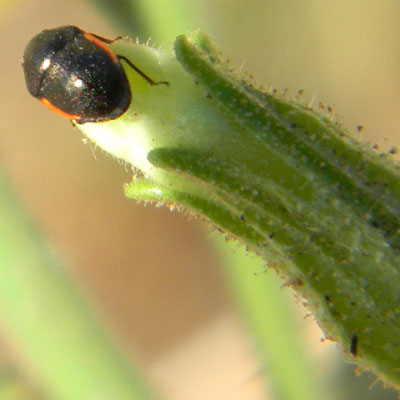Negro Bug
Corimelaena incognita (?)

Photographed at 28 Aug. 2010 along the Hassayampa River, Maricopa Co., Arizona, USA. The specimen is less than 3 mm.
Thyreocoridae -- Negro Bug Family
The host plant for this specimen is Desert Tobacco (Nicotiana obtusifolia). By late spring through autumn when there are plenty of developing seeds, very small dark bugs in the family Thyreocoridae are almost always present. With piercing-sucking mouthparts they feed on the developing seeds.
Desert Tobacco leaves and stems are covered with plant hairs tipped with sticky glands. Look carefully at the plant and many small insects will be found mired in the glue. Negro bugs appear to have a unique ability to move through the hairs without getting stuck. Something related to the chemistry of the exterior cuticle keeps the glue from sticking. Any biochemical engineers reading?
These small bugs appear very much like beetles. Careful observation will provide three clues that they are not beetles (coleoptera): (1) The hardened shell covering the abdomen lacks a seam down the center line - in beetles the 'shell' is derived from a pair of hardened wings known as elytra that can fold back revealing the second pair of flight wings. (2) Immature bugs can usually be found nearby without a complete 'shell' and smaller in size. Beetles are all holometabolous - i.e. their immature stage is a larva or worm-like grub. (3) Finally with a good magnification the mouth parts are of elongated piercing-sucking structures.
Negro bugs as their name suggests are almost uniformly black and a quite small. Most species are just a few mm's long. The abdomen is covered by a hardened shield derived from the scutellum (which is much smaller in related stink bugs). Adult negro bugs have wings that can be extended from under the shield. They feed by inserting their elongated mouthparts mostly into developing seeds and fruits. Like stink bugs they can also release obnoxious-smelling compounds when disturbed.